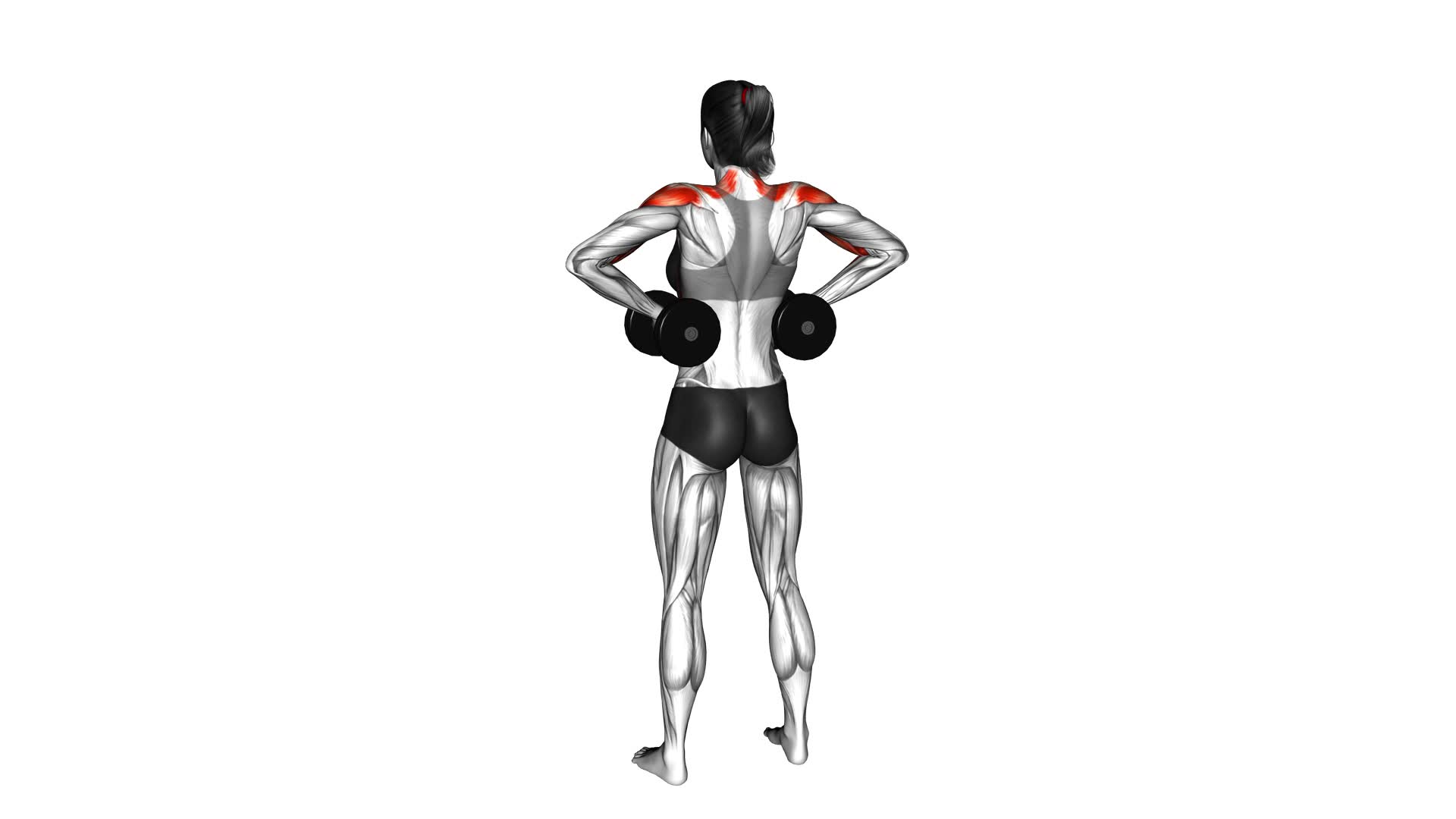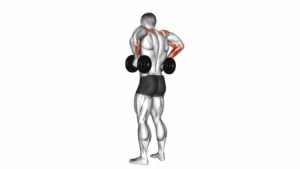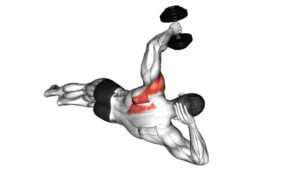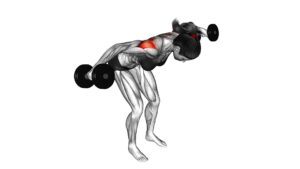Dumbbell Rear Delt Raise (female) – Video Exercise Guide & Tips

Are you looking to target and strengthen your rear deltoid muscles? Then the dumbbell rear delt raise is the perfect exercise for you.
Watch This Exercise Video
In this video exercise guide, we will show you the proper form and technique to maximize your results. You'll also learn how to choose the right weight and challenge yourself with variations.
Avoid common mistakes and incorporate this exercise into your workout routine for a stronger, more defined upper body.
Let's get started!
Key Takeaways
- Dumbbell Rear Delt Raise targets and activates the muscles in the rear deltoids.
- Proper form and technique are crucial for achieving the desired results and avoiding injury.
- Choosing the right weight that challenges you but allows for proper form is important.
- There are variations of the exercise that can be incorporated to challenge yourself and target different muscle groups.
Benefits of Dumbbell Rear Delt Raise
To begin, you'll learn about the benefits of performing the Dumbbell Rear Delt Raise exercise. This exercise specifically targets and activates the muscles in your rear deltoids, which are located at the back of your shoulders. By incorporating this exercise into your workout routine, you can experience several advantages.
Firstly, the Dumbbell Rear Delt Raise helps in achieving proper execution. By holding a dumbbell in each hand and bending forward at the hips, you engage your rear deltoids as you lift the weights out to the sides. This movement ensures that you're targeting the correct muscles and performing the exercise correctly. It also allows for a greater range of motion compared to other shoulder exercises.
Secondly, the Dumbbell Rear Delt Raise effectively activates the targeted muscles. By isolating the rear deltoids, this exercise allows for a more focused and intense workout. This can lead to increased strength and muscle development in your shoulders, ultimately improving your overall upper body strength and posture.
Proper Form and Technique
To execute the Dumbbell Rear Delt Raise exercise with proper form and technique, start by standing upright with a dumbbell in each hand. Keep your feet shoulder-width apart and your knees slightly bent. Engage your core and maintain a straight back throughout the exercise.
Begin by raising your arms out to the sides, keeping them straight and parallel to the floor. Imagine squeezing your shoulder blades together as you lift the dumbbells. Be sure to maintain control and avoid any swinging or jerking movements.
As you reach the top of the movement, pause for a brief moment and focus on contracting your rear deltoid muscles. Slowly lower the dumbbells back to the starting position, keeping your arms straight and maintaining control.
Proper form and technique are essential for maximizing the benefits of shoulder exercises like the Dumbbell Rear Delt Raise. By using the correct form, you'll effectively target and strengthen the rear deltoid muscles, improving shoulder stability and posture.
It's important to be mindful of your body positioning and movement throughout the exercise to avoid any potential injuries or strain. So, remember to maintain proper form, control your movements, and focus on engaging the targeted muscles for optimal results.
Choosing the Right Weight
Choose the appropriate weight for the Dumbbell Rear Delt Raise by considering your strength and fitness level. Selecting the right weight is crucial to ensure an effective workout and avoid injury. It's important to find a weight that challenges you but still allows you to maintain proper form throughout the exercise.
When choosing a weight for the Dumbbell Rear Delt Raise, start with a lighter weight and gradually increase as you become more comfortable and stronger. It's better to start with a weight that feels too light rather than too heavy, as using weights that are too heavy can lead to improper form and increase the risk of injury.
To determine the appropriate weight, consider your current strength and fitness level. If you're a beginner or have limited strength, start with a weight that allows you to perform the exercise with proper technique for 10-12 repetitions. If you can easily complete the set, it may be time to increase the weight slightly. On the other hand, if you struggle to complete the set with proper form, the weight may be too heavy, and it's advisable to decrease it.
Variations to Challenge Yourself
Challenge yourself with different variations of the Dumbbell Rear Delt Raise exercise to take your workout to the next level. By incorporating advanced techniques, you can maximize muscle activation and achieve greater results.
One variation you can try is the Bent-Over Rear Delt Raise. Instead of standing upright, bend at the waist and maintain a slight bend in your knees. This variation places more emphasis on your rear deltoids and challenges your balance and stability.
Another option is the Arnold Rear Delt Raise. Start with your palms facing your body, raise the dumbbells out to the sides, and rotate your palms to face forward as you continue the movement. This variation targets your rear deltoids from a different angle and adds a rotational element to the exercise.
Lastly, the Cable Rear Delt Raise is a great variation to challenge your muscles with constant tension throughout the movement. Attach a D-handle to a low cable pulley, stand facing away from the machine, and raise your arms out to the sides. As you bring your arms back down, maintain control and feel the resistance throughout.
By incorporating these variations into your routine, you can keep your muscles guessing and continue to make progress.
Now, let's explore some common mistakes to avoid to ensure proper form and prevent injury.
Common Mistakes to Avoid
To prevent injury and ensure proper form, it's important to be aware of and avoid these common mistakes when performing the Dumbbell Rear Delt Raise exercise.
One common mistake to avoid is using excessive weight. It's crucial to choose a dumbbell that's suitable for your strength level. Using too heavy of a weight can compromise your form and increase the risk of injury.
Another mistake to watch out for is swinging the dumbbells. This can happen when you use momentum to lift the weights instead of relying on the strength of your rear delts. To avoid this, focus on keeping your movements controlled and slow throughout the exercise.
Additionally, avoid arching your back or hunching your shoulders. These postural mistakes can put unnecessary strain on your spine and shoulders. Instead, maintain a neutral spine and keep your shoulders relaxed and down.
Lastly, it's important to keep your elbows slightly bent throughout the exercise. Straightening your arms completely can lead to hyperextension and potential injury.
Incorporating Dumbbell Rear Delt Raise Into Your Workout Routine
To incorporate the dumbbell rear delt raise into your workout routine, there are a few key points to keep in mind.
Firstly, this exercise specifically targets the muscles in your shoulders, helping to improve their strength and definition.
Secondly, it's important to maintain proper form throughout the movement, ensuring that you're engaging the correct muscles and minimizing the risk of injury.
Lastly, incorporating variations of the dumbbell rear delt raise, such as using different weights or angles, can provide additional benefits and help prevent plateauing in your fitness progress.
Shoulder Muscle Targeting
How can you effectively target your shoulder muscles by incorporating the dumbbell rear delt raise into your workout routine?
The dumbbell rear delt raise is a great exercise for specifically targeting the rear deltoid muscles, which are located at the back of your shoulders. This exercise primarily focuses on shoulder muscle activation, specifically the rear deltoids.
To perform the dumbbell rear delt raise, start by standing with your feet shoulder-width apart and a dumbbell in each hand. Bend slightly at the waist, keeping your back straight. Then, raise your arms out to the sides, squeezing your shoulder blades together as you lift the weights. Remember to keep your elbows slightly bent and your wrists in line with your forearms throughout the movement.
Incorporating this exercise into your workout routine will help you effectively target and strengthen your shoulder muscles.
Proper Form Tips
When incorporating the dumbbell rear delt raise into your workout routine, focus on maintaining proper form. Proper form is crucial to ensure that you're targeting the correct muscles and minimizing the risk of injury. Here are some tips to help you maintain proper form during the dumbbell rear delt raise:
- Stand with your feet shoulder-width apart and a slight bend in your knees.
- Hold a dumbbell in each hand with your palms facing your body.
- Keep your back straight and engage your core.
- Raise your arms out to the sides, keeping a slight bend in your elbows.
- Focus on squeezing your shoulder blades together as you lift the dumbbells.
- Avoid swinging your body or using momentum to lift the weights.
Benefits of Variation
To enhance your workout routine, incorporating the dumbbell rear delt raise offers a variety of benefits.
One of the main benefits is the ability to modify the exercise to target different areas of your shoulders and upper back. By changing the grip, hand position, or range of motion, you can engage different muscles and prevent plateauing. This variation also helps to improve overall shoulder strength and stability.
Additionally, adding the dumbbell rear delt raise to your routine provides different exercise options. You can perform it standing, seated, or even lying face down on an incline bench. This allows you to switch up your workouts and keep your muscles guessing, leading to better results and preventing boredom.
Frequently Asked Questions
How Many Sets and Reps Should I Do for Dumbbell Rear Delt Raises?
For dumbbell rear delt raises, you should aim for 3-4 sets of 10-15 reps. This exercise is great for improving shoulder mobility and targeting the rear deltoid muscles.
By incorporating these raises into your routine, you can strengthen your shoulders and improve your posture. The benefits of rear delt exercises include better shoulder stability and enhanced upper body strength.
Remember to start with lighter weights and gradually increase as you get stronger.
Can I Do Dumbbell Rear Delt Raises if I Have Shoulder Pain or Injury?
If you have shoulder pain or an injury, it's important to be cautious when doing any exercises that involve the shoulders.
It's best to consult with a medical professional or physical therapist who can provide guidance on whether it's safe for you to do dumbbell rear delt raises.
They can also recommend specific shoulder pain prevention strategies or rehabilitation exercises that are suitable for your condition.
Prioritizing your safety and health is key when dealing with shoulder issues.
Will Dumbbell Rear Delt Raises Help Me Build Muscle Mass in My Shoulders?
Dumbbell rear delt raises are a great exercise for building muscle mass in your shoulders. By targeting the rear deltoids, these raises help to strengthen and develop the muscles in this area.
The benefits of including this exercise in your routine include improved shoulder stability, enhanced posture, and increased shoulder strength.
There are variations of this exercise that you can try, such as using different weights or incorporating resistance bands, to challenge your muscles in different ways and continue to see progress.
Can I Perform Dumbbell Rear Delt Raises With Other Exercises for a Full Shoulder Workout?
Yes, you can definitely incorporate dumbbell rear delt raises with other exercises to create a full shoulder workout.
By adding this exercise to your routine, you can target and strengthen your rear deltoid muscles, which will improve your overall shoulder definition and stability.
Combining dumbbell rear delt raises with other shoulder exercises like overhead presses and lateral raises can provide a well-rounded shoulder workout that targets all areas of the shoulder muscles.
Are There Any Modifications or Alternatives for Dumbbell Rear Delt Raises if I Don't Have Access to Dumbbells?
If you don't have access to dumbbells, there are alternatives and modifications you can try for the dumbbell rear delt raises.
One option is to use resistance bands instead of dumbbells.
You can also perform the exercise using household items like water bottles or cans as weights.
Another modification is to do bent-over lateral raises, which target the same muscles but without the need for dumbbells.
Remember to focus on proper form and gradually increase the intensity as you progress.
Conclusion
Incorporating the dumbbell rear delt raise into your workout routine can provide numerous benefits for your upper body strength and posture. By maintaining proper form and technique, choosing the right weight, and challenging yourself with variations, you can effectively target and strengthen your rear deltoid muscles.
Avoiding common mistakes will help maximize the effectiveness of this exercise. So why not give the dumbbell rear delt raise a try and enjoy the benefits it brings to your fitness journey.

Author
Years ago, the spark of my life’s passion ignited in my mind the moment I stepped into the local gym for the first time. The inaugural bead of perspiration, the initial endeavor, the very first surge of endorphins, and a sense of pride that washed over me post-workout marked the beginning of my deep-seated interest in strength sports, fitness, and sports nutrition. This very curiosity blossomed rapidly into a profound fascination, propelling me to earn a Master’s degree in Physical Education from the Academy of Physical Education in Krakow, followed by a Sports Manager diploma from the Jagiellonian University. My journey of growth led me to gain more specialized qualifications, such as being a certified personal trainer with a focus on sports dietetics, a lifeguard, and an instructor for wellness and corrective gymnastics. Theoretical knowledge paired seamlessly with practical experience, reinforcing my belief that the transformation of individuals under my guidance was also a reflection of my personal growth. This belief holds true even today. Each day, I strive to push the boundaries and explore new realms. These realms gently elevate me to greater heights. The unique combination of passion for my field and the continuous quest for growth fuels my drive to break new ground.







